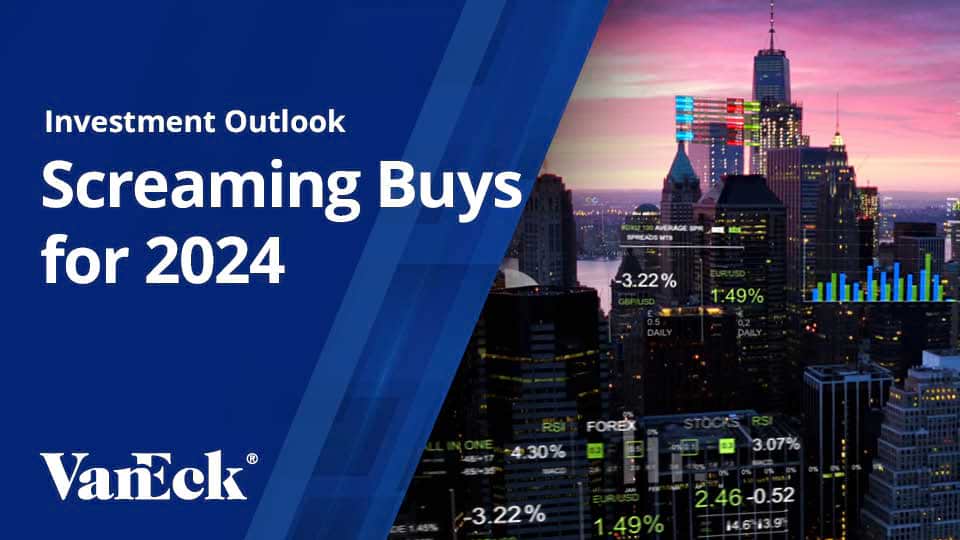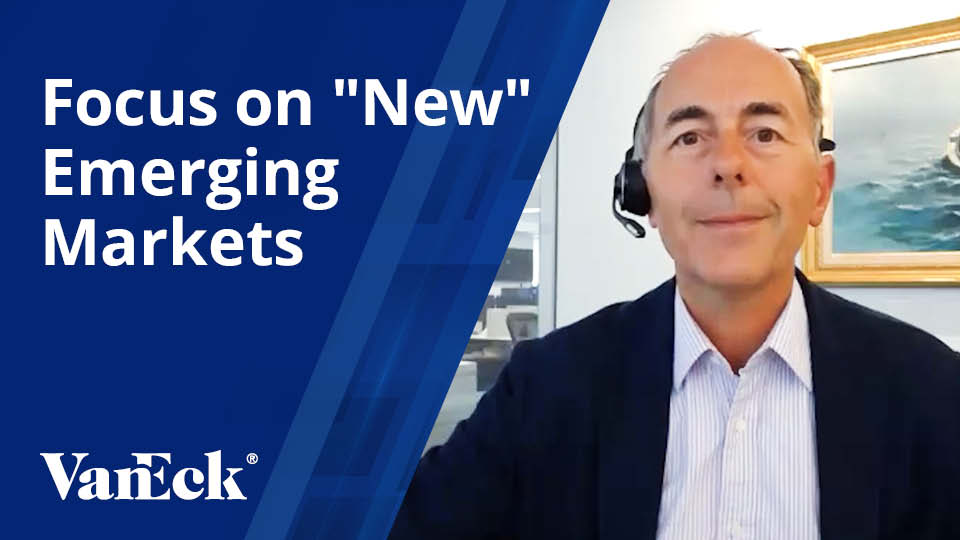Resources Regroup for 2024
30 January 2024
Share with a Friend
All fields required where indicated (*)Quarterly insights from Global Resources Portfolio Manager Shawn Reynolds, featuring his unique views on natural resources and commodities.
Mixed Performance on the Quarter
Performance of resource equities was mixed on the quarter. Broadly speaking, the sector’s most respectable gains were concentrated in mining, including within the sub-sectors of Base & Industrial Metals and Gold & Precious Metals. Sub-sectors such as Renewable & Alternative Energy and Industrials & Utilities saw modest rallies to end the year, though mostly off of recent lows. Meanwhile, a majority of the Oil & Gas sub-sector experienced losses, marking a notable pullback from their mid-year peak.
Landmark M&A in Oil & Gas
Oil price declines in the fourth quarter were highlighted by weakening demand growth paired with stronger-than-anticipated output—particularly out of the U.S. In its December 2023 Oil Market Report, IEA noted how U.S. oil supply growth “continues to defy expectations, with output shattering the 20 mb/d [million barrels per day] mark.”i OPEC+’s announced plans to extend oil production cuts through the first quarter of 2024 appeared to have little impact on halting crude’s slide. WTI crude prices dropped some $25/bbl from the end of September into early December before eventually settling at around $72/bbl to end the year (a 10% decline from end-2022).
Mergers and acquisition activity within the U.S. exploration and production (E&P) industry reached a zenith in the fourth quarter with ExxonMobil’s (2.48% of Strategy net assets*) announced all-stock purchase of Pioneer Natural Resources (1.07% of Strategy net assets*) and Chevron’s (0.99% of Strategy net assets*) similarly-structured agreement to purchase Hess (0.51% of Strategy net assets*). The deals, both valued above $50 billion, capped off a reported $250 billion spending spree in the industry for 2023.ii
Hope for Renewables Heading Into 2024?
Solar module prices hit new lows during the quarter, with supply still vastly outstripping demand. Global imbalances remained largely fueled by excess capacity in China, where the cost to produce a panel fell by over 40% in the last year.iii Declining industry costs, as well as government-fueled subsidies from the Inflation Reduction Act, are believed to have aided with a record 33 gigawatts of installed solar capacity in the U.S., and 413 gigawatts worldwide, in 2023.iv
Investor sentiment around renewable and alternative energy companies saw a marked improvement during the quarter. Higher borrowing costs have been a significant contributor to a more muted outlook for the space – particularly for companies such as renewable energy project financier, Hannon Armstrong (2.05% of Strategy net assets*) – and U.S. Federal Reserve (Fed)-telegraphed rate cuts in 2024 helped restore some optimism beginning in October.
Much-Needed Boost for Base Metals
Base and industrial metals markets limped into the fourth quarter as concerns over China’s real estate sector weighed on prices for much of the year. “Green” metals and minerals – such as lithium, nickel, cobalt and graphite – contended with projected supply overhangs, in part due to disappointing EV sales in the U.S and ongoing supply-chain bottlenecks in clean energy markets. Copper and iron ore were spared before year-end with reported inventory declines in China and at the London Metal Exchange, as well as with a slew of ongoing disruptions at major production sites around the world.
First Quantum (0.48% of Strategy net assets*) was among those most significantly impacted by disruptions to its mine operations. In November, Panamanian government officials ordered the closure of First Quantum’s Cobre Panama mine which, according to Bloomberg, accounted for approximately 1.5% of copper supply in 2022.v While certainly less dramatic, in October, Vale (2.86% of Strategy net assets*) announced a two-million-ton impact to its iron ore production—occurring in the third quarter—due to vital equipment failure at its norther Brazilian mining complex.vi
Gold’s Still Shining
Gold reached a new all-time high in December. Reported strength in central bank purchases, rising global geopolitical tensions and forecasted rate cuts in 2024 outweighed otherwise-lackluster investment demand for physical gold through most of the second half of 2023.
Gold miners, who largely underperformed the metal heading into the fourth quarter, showcased their ability to outperform. In November, Newmont (1.70% of Strategy net assets*) announced its successful, $15 billion bid for Newcrest (not held by Strategy). The acquisition is estimated to bring Newmont’s net value to approximately $50 billion while also adding several highly-attractive, non-core assets to its mining portfolio.vii
Ags Still Seeking a Near-Term Catalyst
Nearly the whole of the agriculture complex added to its year-to-date losses during the fourth quarter. U.S. stocks of wheat and corn ended the year higher while usage remained fairly flat on slowing exports and lower demand for animal feed. Fertilizer prices continued to stabilize with European supplies of natural gas (a key input for nitrogen fertilizers) appearing less precarious than a year ago. Proteins were mixed; cattle prices retreated from all-time highs on record imports while chicken broiler prices spiked on reports of a resurgence in avian flu.
Modest share price gains of protein producers and farm equipment manufacturers were the lone standouts among agriculture companies during the final months of 2023. However, on the whole, the agriculture sub-sector struggled to find firm footing.
Looking Ahead to 2024
From a macroeconomic perspective, commodities and resource equities continue to be most strongly influenced by the perceived trajectory of global economic growth and inflation. As such, the health of economies in China, United States, Europe and, increasingly so, India, remain a critical area of focus for us, for now. We are closely monitoring indications that the era of interest rate hikes may have concluded and that a global recession may have been successfully avoided. Such a case would prove, in our view, generally constructive for the operating environments of a number of our portfolio companies, with any incremental measures likely to be stimulative for demand.
Inflation has come down but remains above most key targets, implying, to us, a “higher-for-longer” outlook. The risk that inflation trends reverse or that inflation remains at current levels, while regarded as negative for economic growth, would likely still prove somewhat beneficial for inflation-hedging assets such as commodities and resource equities. A recession, even if mild, would certainly be considered a worst-case-scenario, as this would likely lessen the perceived importance of these assets significantly.
Macroeconomics aside, clear to us is that many of the other major, fundamentally-driven factors propelling resource companies to their 2022 highs still remain the same today. Supply for a number of commodities continues to be constrained due to a lack of capital investment, operational limitations and aligned executive compensation schemes. Resource companies, bolstered by structural advantages and years of efficiency-focused operations, remain uniquely positioned to benefit. Their tangible assets, strong financial health, commitment to shareholder value and attractive valuations still make them compelling investment opportunities, in our view.
* Each holding as a percentage of the Strategy’s net assets is as of December 31, 2023.
i Oil Market Report - December 2023.
ii Big oil enters 2024 strengthened by U.S. industry consolidation.
iii China solar panel costs drop 42% from year ago - report.
iv Global PV Market Outlook, 4Q 2023.
v First Quantum Suspends Copper Production in Panama Amid Blockade.
vi Vale's iron-ore output falls as operations failure hits key mine.
Important Disclosure
This is a marketing communication. Please refer to the prospectus of the UCITS and to the KID before making any final investment decisions.
This information originates from VanEck (Europe) GmbH, which has been appointed as distributor of VanEck products in Europe by the Management Company VanEck Asset Management B.V., incorporated under Dutch law and registered with the Dutch Authority for the Financial Markets (AFM). VanEck (Europe) GmbH with registered address at Kreuznacher Str. 30, 60486 Frankfurt, Germany, is a financial services provider regulated by the Federal Financial Supervisory Authority in Germany (BaFin).
The information is intended only to provide general and preliminary information to investors and shall not be construed as investment, legal or tax advice VanEck (Europe) GmbH, VanEck Switzerland AG, VanEck Securities UK Limited and their associated and affiliated companies (together “VanEck”) assume no liability with regards to any investment, divestment or retention decision taken by the investor on the basis of this information. The views and opinions expressed are those of the author(s) but not necessarily those of VanEck. Opinions are current as of the publication date and are subject to change with market conditions. Certain statements contained herein may constitute projections, forecasts and other forward-looking statements, which do not reflect actual results. Information provided by third party sources is believed to be reliable and have not been independently verified for accuracy or completeness and cannot be guaranteed. Brokerage or transaction fees may apply.
All performance information is based on historical data and does not predict future returns. Investing is subject to risk, including the possible loss of principal.
No part of this material may be reproduced in any form, or referred to in any other publication, without express written permission of VanEck.
© VanEck (Europe) GmbH / VanEck Asset Management B.V.
Sign-up for our ETF newsletter
Related Insights
Related Insights
10 October 2023
08 December 2023
10 October 2023
10 October 2023





